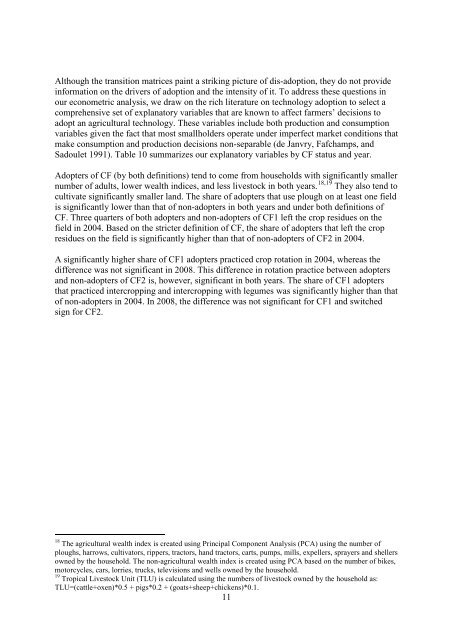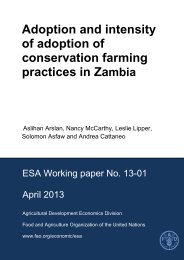Adoption and intensity of adoption of conservation farming practices in Zambia
Adoption and intensity of adoption of conservation farming practices in Zambia
Adoption and intensity of adoption of conservation farming practices in Zambia
Create successful ePaper yourself
Turn your PDF publications into a flip-book with our unique Google optimized e-Paper software.
Although the transition matrices pa<strong>in</strong>t a strik<strong>in</strong>g picture <strong>of</strong> dis-<strong>adoption</strong>, they do not provide<br />
<strong>in</strong>formation on the drivers <strong>of</strong> <strong>adoption</strong> <strong>and</strong> the <strong><strong>in</strong>tensity</strong> <strong>of</strong> it. To address these questions <strong>in</strong><br />
our econometric analysis, we draw on the rich literature on technology <strong>adoption</strong> to select a<br />
comprehensive set <strong>of</strong> explanatory variables that are known to affect farmers’ decisions to<br />
adopt an agricultural technology. These variables <strong>in</strong>clude both production <strong>and</strong> consumption<br />
variables given the fact that most smallholders operate under imperfect market conditions that<br />
make consumption <strong>and</strong> production decisions non-separable (de Janvry, Fafchamps, <strong>and</strong><br />
Sadoulet 1991). Table 10 summarizes our explanatory variables by CF status <strong>and</strong> year.<br />
Adopters <strong>of</strong> CF (by both def<strong>in</strong>itions) tend to come from households with significantly smaller<br />
number <strong>of</strong> adults, lower wealth <strong>in</strong>dices, <strong>and</strong> less livestock <strong>in</strong> both years. 18,19 They also tend to<br />
cultivate significantly smaller l<strong>and</strong>. The share <strong>of</strong> adopters that use plough on at least one field<br />
is significantly lower than that <strong>of</strong> non-adopters <strong>in</strong> both years <strong>and</strong> under both def<strong>in</strong>itions <strong>of</strong><br />
CF. Three quarters <strong>of</strong> both adopters <strong>and</strong> non-adopters <strong>of</strong> CF1 left the crop residues on the<br />
field <strong>in</strong> 2004. Based on the stricter def<strong>in</strong>ition <strong>of</strong> CF, the share <strong>of</strong> adopters that left the crop<br />
residues on the field is significantly higher than that <strong>of</strong> non-adopters <strong>of</strong> CF2 <strong>in</strong> 2004.<br />
A significantly higher share <strong>of</strong> CF1 adopters practiced crop rotation <strong>in</strong> 2004, whereas the<br />
difference was not significant <strong>in</strong> 2008. This difference <strong>in</strong> rotation practice between adopters<br />
<strong>and</strong> non-adopters <strong>of</strong> CF2 is, however, significant <strong>in</strong> both years. The share <strong>of</strong> CF1 adopters<br />
that practiced <strong>in</strong>tercropp<strong>in</strong>g <strong>and</strong> <strong>in</strong>tercropp<strong>in</strong>g with legumes was significantly higher than that<br />
<strong>of</strong> non-adopters <strong>in</strong> 2004. In 2008, the difference was not significant for CF1 <strong>and</strong> switched<br />
sign for CF2.<br />
18<br />
The agricultural wealth <strong>in</strong>dex is created us<strong>in</strong>g Pr<strong>in</strong>cipal Component Analysis (PCA) us<strong>in</strong>g the number <strong>of</strong><br />
ploughs, harrows, cultivators, rippers, tractors, h<strong>and</strong> tractors, carts, pumps, mills, expellers, sprayers <strong>and</strong> shellers<br />
owned by the household. The non-agricultural wealth <strong>in</strong>dex is created us<strong>in</strong>g PCA based on the number <strong>of</strong> bikes,<br />
motorcycles, cars, lorries, trucks, televisions <strong>and</strong> wells owned by the household.<br />
19<br />
Tropical Livestock Unit (TLU) is calculated us<strong>in</strong>g the numbers <strong>of</strong> livestock owned by the household as:<br />
TLU=(cattle+oxen)*0.5 + pigs*0.2 + (goats+sheep+chickens)*0.1.<br />
11



